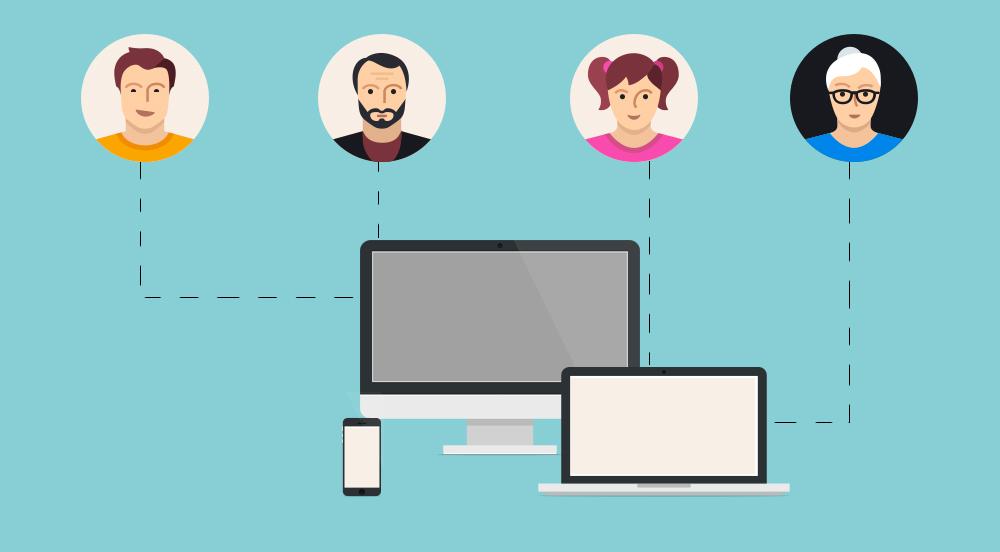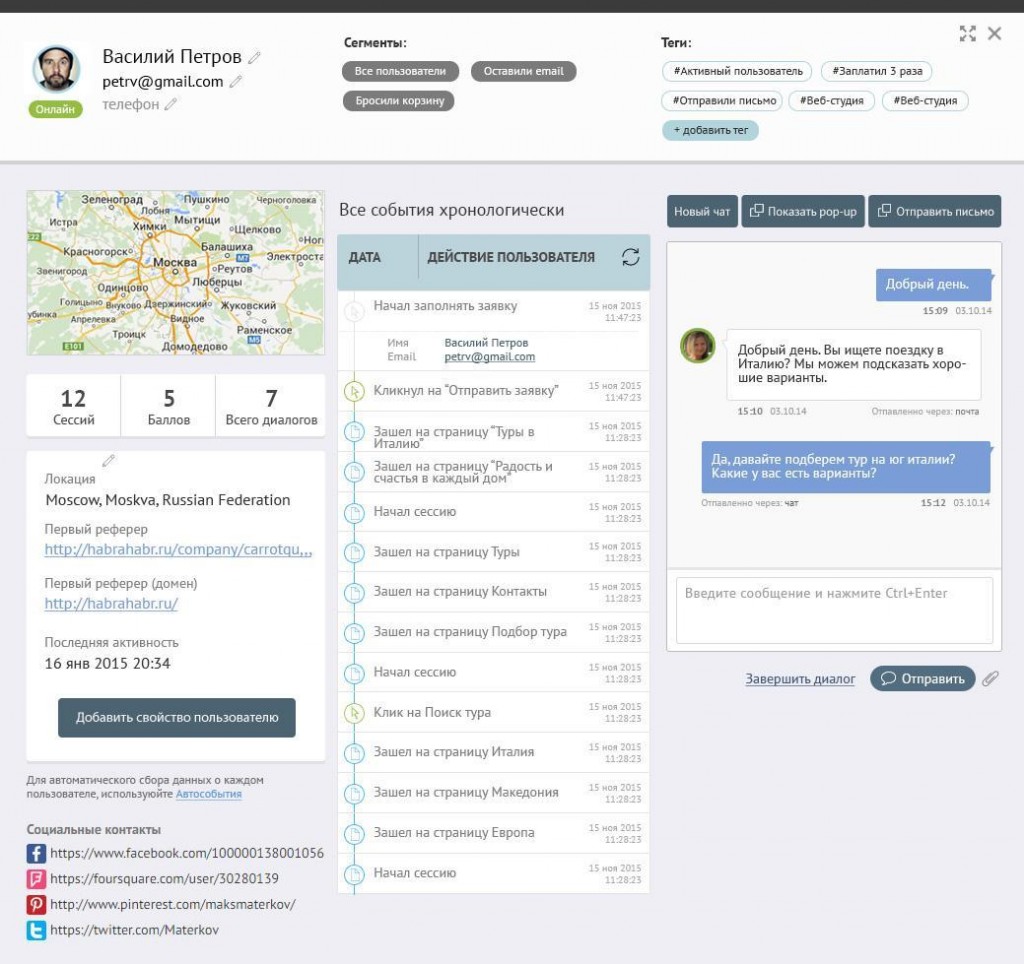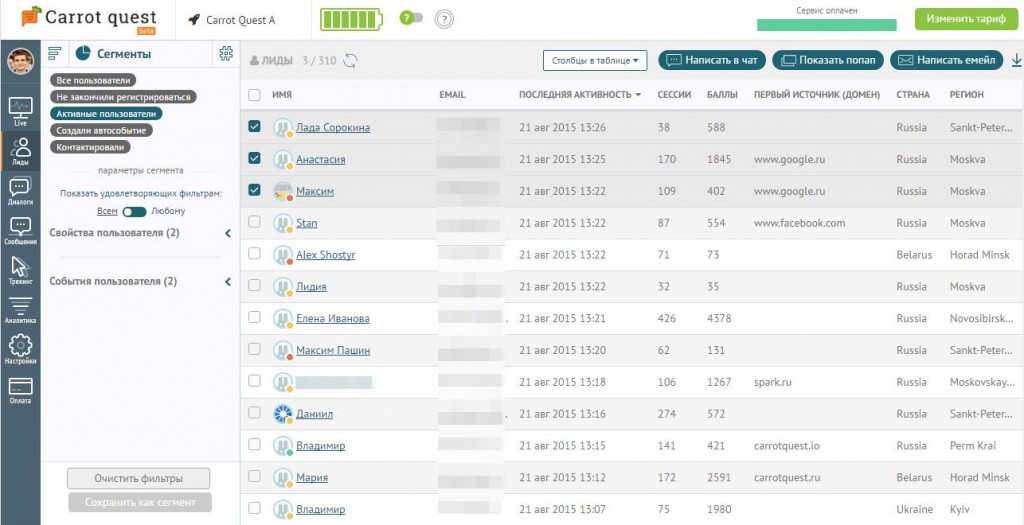Collecting data about each user, smart segmentation and targeting - combo marketer for 2016

Your business is growing, and so is your customer base. However, do not forget about the personal approach to each client. Sending the same letter to all your customers, you will not achieve anything except the alienation of the user.
All customers are completely different. It is logical that your marketing strategy should not be tailored to one type of client ..
How to achieve a personalized approach? Simply use user and automated marketing in combination. For example, in the Carrot Quest service you collect key information about clients (their profiles in social networks, actions on the site, referral sources, what letters the user read, etc.), set up automatic scripts for working with them, collect statistics and get the result .
')
It is all about personalization.
Customers love personal touch. Studies have shown that 75% of US customers appreciate individual offers. Do you think our users are different from foreign? Yes, you are right, they do not differ much, because everyone expects (wants) an individual approach to himself.
Your business exists in order to satisfy someone's needs, that is, your customers will appreciate the individual approach.
Personalization is not just contacting the user by name at the beginning of the letter. Personalization is the compilation of an individual (actual) message for a user or a narrow segment, based on his behavior on the site and on the whole on the Internet. To learn more about your customers, you need to hear and see them, but not in the traditional sense.
Collection of information about user behavior
Profiles in social networks, actions on the site, referral sources, data on emails - these are the “beacons” for which you track the path, needs and interests of the client. Service Carrot Quest combines the collection of information about users and automated marketing.
By connecting data from several beacons, you can use this information in creating incentives to engage your user in a purchase.
Get all sorts of information about your users:
- the source of the transition to the site (to know where the client came from, with contextual advertising or with a PR article);
- city and region;
- information about profiles in social. networks;
- actions that the user did on the site (for example, registered, added the product to the basket, subscribed to the newsletter, paid the subscription twice, did not return to the site for 14 days or came again, and any other action);
- data that they left on the site (mail, names, dialogues with employees, etc.)
- loyalty and willingness to purchase (scoring users by points);
- the amount of money that the user brought.
Here is how a part of the collected data in each user's card looks like:

Imagine how your efficiency increases and the work becomes easier if you know who your customers are. Now you are segmenting the audience not by classical marketing, as it was done before (gender, age, marital status, etc.), but you see the hidden motives and interests of each segment, which will help to make the most relevant offer for them. In essence, build profiles of all typical characters (segmentation from content marketing).
Users differ in a number of parameters, at least they are all at different stages of purchase (someone just found out about your product, someone has been comparing you with competitors for a month, someone has bought it again 5 times, etc. ). Agree, it will be ineffective if all these users send the same offer.
Data is collected automatically. According to the collected data, you can carry out point segmentation, select completely different groups of people. About this further.
Segmentation
Segmenting customers and potential customers in detail, you are sending more individual, suitable messages to a particular group of people. If you are trying to send the client information that interests him, this is personalization.
For example, you create a list of visitors who have watched a video about your service; you can send them a message with an interesting case study about your service. Simultaneously with the promotion of the service you are answering possible questions that may arise from the customer regarding the product. In fact, lead it through the sales funnel. And since he is interested in the content that you sent, he will not throw it into the spam folder.
You can segment users by the data you collect about them. Here are some examples of segments:
- Users who have not completed registration;
- Came from a webinar;
- The segment of those who subscribed to the blog and read 2 articles;
- New leads;
- Users from Moscow;
- And etc.
Important! You can make your segments completely from different parameters. It all looks like a designer. For example, why not single out such a segment: new leads that are in Moscow and have not yet completed registration.
All segments you can save and continue working with them. Here is how it looks in the service:

These are just a couple of segmentation examples. By separating your customers according to their behavior, you can identify individual segments of your market and create content, the purpose of which is to satisfy the information needs of the customer.
Important: when communicating directly with any user, you immediately see which segment it belongs to (this is relevant for operators, support)
Targeting by users
After segmentation, you can prioritize segments and select the best solution for a particular category of customers. Careful preparation of your letter for one particular group will be a much more verified strategy than recklessly sending the same identical information to everyone in a row.
For different users, not only the content itself will be different, but with what tools you deliver it to the user (when and where he sees it).
In Carrot Quest, after selecting the segment you need, you can connect with it using 3 tools (chat, pop-up windows, email-mailing). At the same time, your actions can be both automated and manual.

So, how to prepare a personalized letter? Depends on your goals, but there are some unmistakable options :
1. Drip marketing is a great way to heat leads and gradually bring them to sale. Users step by step receive letters that offer solutions to a particular problem, and gradually they get used to you and begin to trust you.
Here is a case for drop emails, which gave a stunning effect (2.5 times increase in incoming applications)
2. The use of activation letters can also bear fruit in working with new customers. For example, you sell the SaaS service, but first you offer a free trial.
Trigger mailing, which offers users on the trial the necessary information about the work of the service, can increase addiction to its convenience and ensure future sales
Previously, we parsed the activation letters and how to use them effectively .
3. Discounts, recommendations and promotions - great and long-used marketing moves. Just recheck the targeted audience of the same actions - why should a person send a coupon to buy a T-shirt, if he has already bought it?
Supervision and control
Everything that we have discussed sounds cumbersome, but do not worry, the combination of collecting customer information and automated marketing provide a large and useful base. Such accurate information allows you to focus on those places where you have traffic sagging, or you need to pull something up.
This is not the type of service that “installed and forgot”. The work process at Carrot Quest needs to be managed and monitored to increase efficiency. Having incorporated into the database customer information, you personalize and automate your communication with them, all this will increase the conversion and customer attitudes to your brand (which will increase the average check and LTV).
Directly in the service, track your changes, how this or that newsletter affected sales, how your operators work and whether you have chosen the right course.
You will understand the usefulness of these actions as soon as your monthly income crawls up.
With pleasure, the Carrot Quest internet marketing automation service team.
Source: https://habr.com/ru/post/297326/
All Articles